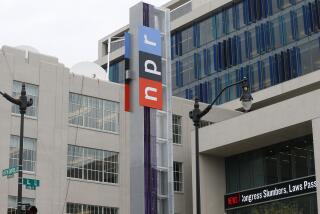Memo to public radio: Less talk, more Telemann
- Share via
WASHINGTON — A new report from the National Endowment for the Arts blasts public radio, saying it fails to fulfill its obligation to provide music that commercial stations won’t touch. The NEA says public radio -- once dominated by classical, jazz and other niche forms of music -- is retreating ever further from that mission, choosing to focus on news and talk.
National Public Radio pleads guilty to using its new resources to build a stronger news operation but rejects the NEA’s notion that public radio is abandoning its cultural mission. Rather, NPR maintains, it plans to use the Web and other emerging technologies to introduce a new generation of listeners to music you can’t hear on the radio.
The NEA study, prompted by the dramatic decline in classical programming, hits public radio especially hard for the practice of duplicating news programming on multiple stations in a single city.
“There appears to be a tendency for public stations to discourage music programming in favor of news-talk broadcasts as a way to draw larger audiences,” the NEA study says. But because it receives tax dollars, “public radio has an obligation beyond maximizing audiences.” The NEA concludes that public radio “should balance its drive for audiences and revenues with a commitment to cultural programming and services that are not necessarily profitable.”
But Ken Stern, NPR’s chief executive, says the nation’s public stations are staying true to their purpose by emphasizing news on the radio and creating online ventures that aim to keep listeners aware of the latest in classical, jazz, adult alternative, bluegrass and other non-pop musical genres.
“We work in a complicated media environment,” Stern says. “We have to fish where the fish are. We’ve made some strategic choices.”
NPR has expanded its menu of news programs, added employees and bureaus and grown into one of the nation’s most comprehensive news outlets. Three factors have driven this expansion: the growing audience for news shows; the fact that news listeners tend to donate more money than music listeners; and a $200-million bequest from Joan Kroc (widow of McDonald’s founder Ray Kroc).
Stern, however, says that even as NPR has halted production of its main classical programs, “Performance Today” and “SymphonyCast,” those programs will not die. They will continue under the direction of American Public Media, a classical music programmer that provides its programs both on the remaining public stations that broadcast music and on an online music service that NPR plans to launch by July 1. On that “digital music space,” listeners will find streaming programs, archived concerts, video performances and background on music and musicians.
“Culture is still a critical part of our public-service mission, but how we do that is going to change,” Stern says. “It’s a mystery to me why the NEA isn’t applauding these moves.”
Instead, the NEA study focuses on radio as the medium through which most people encounter classical music. With the number of commercial classical stations having dropped from 40 in 1998 to 28 last year, the federal agency concludes that only public radio -- which receives $83 million in taxpayer funding -- can introduce the music to a new generation of listeners.
That’s not likely to happen, however, with news replacing classical as the primary format on public stations. In 1994, public radio aired more classical music than news (140,000 hours to 104,000). By last year, that ratio had flipped, with news filling far more time (224,000 hours to 168,000).
The report says there’s no shortage of listeners for classical programming. Classical fans tend to spend more time listening to their public stations than news listeners devote to their stations, according to a public-radio study quoted in the NEA report. But because news listeners tend to give stations larger gifts, many stations have dumped classical music. Although the Los Angeles area has three classical music stations, in 19 of the nation’s top 100 markets, including Miami, Long Island and San Jose, there are none.
More to Read
The biggest entertainment stories
Get our big stories about Hollywood, film, television, music, arts, culture and more right in your inbox as soon as they publish.
You may occasionally receive promotional content from the Los Angeles Times.










